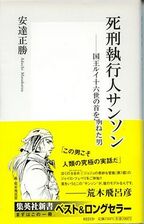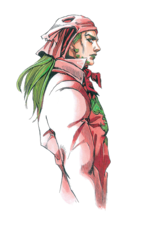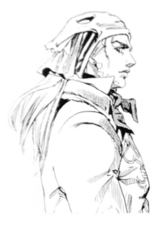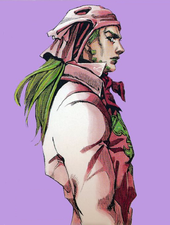Executioner Sanson
Executioner Sanson: The Man Who Beheaded King Louis XVI (死刑執行人サンソン 国王ルイ十六世の首を刎ねた男, Shikei Shikkou-nin Sanson: Kokuō Rui Jūroku-sei no Kubi o Haneta Otoko) is a book written by the Japanese author Masakatsu Adachi. It tells the story of Charles-Henri Sanson, who was a French executioner responsible for the execution of King Louis XVI.
Hirohiko Araki wrote a short review of the book, and later stated that Sanson was the inspiration for the Steel Ball Run character Gyro Zeppeli. Later releases of the book were sold with an illustration of Gyro on the cover.
Summary
The book explores the life of Charles-Henri Sanson, the fourth-generation head of the Sanson family, which served as executioners in Paris. Sanson was a devout Catholic and loyal to the monarchy, but he became famous for carrying out the executions of King Louis XVI and Queen Marie Antoinette during the French Revolution.
The book explores Sanson's inner struggles with his role, his efforts to make executions more humane, and his questions about the morality of the death penalty. It also delves into the broader historical context of the French Revolution, providing insight into the realities of executions at the time and the invention of the guillotine.[2]
Hirohiko Araki
In January 2004, Hirohiko Araki's short review of Executioner Sanson was published in the magazine Business Jump.[3] In 2007, the December issue of the magazine MEN'S NON-NO contained an advertisement of the book, with a a drawing of the Steel Ball Run character, Gyro Zeppeli, in his executioner outfit. It also included a statement from Araki that Gyro was based on Charles-Henri Sanson,[4] who shares his fate of being an executioner by family trade, his side profession as a doctor, and his doubts about the death penalty.[5]
As of the 13th reprinting in 2019 onward, the book began being sold with Araki's message and the colored version of the drawing on the cover.[6]
Araki's Reviews
Gallery
References
- ↑ Official Book Listing
- ↑ Executioner Sanson - amazon.co.jp
- ↑ Book review of "Executioner Sanson" by Hirohiko Araki
- ↑ An illustrated book review by Araki is featured in the advertisement for "Executioner Sanson"!
- ↑ Hirohiko Araki's New Manga Techniques Practical Guide, Part 2 - "Using Real People as Models"
- ↑ Official Book Listing (Archived)






